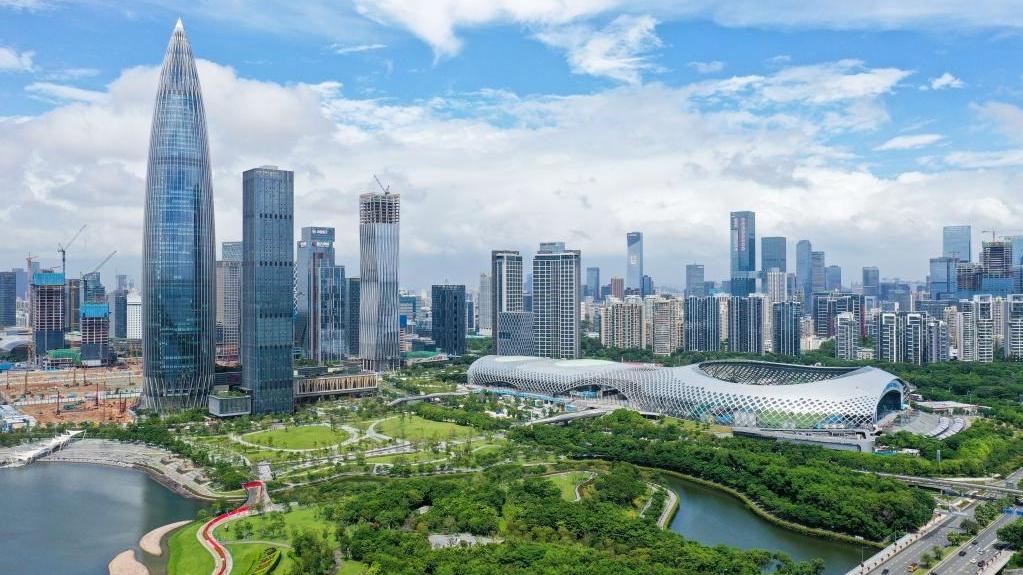 This file photo dated Sept 17, 2020 shows the Houhai area in Nanshan District of Shenzhen, south China's Guangdong province. (PHOTO / XINHUA)
This file photo dated Sept 17, 2020 shows the Houhai area in Nanshan District of Shenzhen, south China's Guangdong province. (PHOTO / XINHUA)
Construction of five metropolitan areas in Guangdong province will inject new impetus to the development of Hong Kong and provide more space for the special administrative region to give play to its strengths in finance, professional services and management, experts said.
The Guangdong provincial government on Wednesday unveiled the development plans for five metropolitan areas — Guangzhou, Shenzhen, the west bank of the Pearl River Estuary, Shan-Chao-Jie, and Zhan-Mao — on its website.
Construction of the five metropolitan areas in Guangdong is closely related to the development of the Greater Bay Area, said Mao Yanhua, dean of the Institute of Regional Openness and Cooperation at Sun Yat-sen University in Guangzhou
The west bank of the Pearl River Estuary covers Zhuhai, Zhongshan, Jiangmen, and Yangjiang. Shan-Chao-Jie refers to Shantou, Chaozhou and Jieyang, while Zhan-Mao is an acronym for Zhanjiang and Maoming.
READ MORE: HK, Guangdong sign deal on education collaboration
With a planning period from 2023 to 2030, the blueprints laid out a road map for the development of the five areas, with each playing a different role in contributing to the coordinated development of the southern region.
For example, Guangzhou metropolitan area, which comprises Guangzhou, Foshan, parts of Zhaoqing, and Qingyuan, is tasked with driving high-quality development of Guangdong province and promoting integration between cities.
The Shenzhen metroplitan area, which covers Shenzhen, Dongguan, Huizhou and Shenshan Special Cooperation Zone, will focus on the development of innovation and technology, with the aim of becoming a core growth engine of the Guangdong-Hong Kong-Macao Greater Bay Area.
Liu Guohong, vice-president of Shenzhen-based think tank China Development Institute, said the development plans of the five metropolitan areas in Guangdong are concrete actions to implement integrated development of the GBA, and a guideline to promoting alignment in urban planning, policy and infrastructure among cities in the 11-city cluster.
“All the five development plans contain content related to cooperation with Hong Kong and Macao,” he said.
“The implementation of these projects will synergize with the development of major projects in Hong Kong such as Northern Metropolis and Lantau Tomorrow Vision, expanding the hinterland to support Hong Kong’s development. It will also enable capital, talent and organizations in Hong Kong to play a bigger role in GBA development and deepen comprehensive cooperation between Hong Kong and the mainland,” he told China Daily.
Mao Yanhua, dean of the Institute of Regional Openness and Cooperation at Sun Yat-sen University in Guangzhou, shared a similar view.
The development will also create a stronger consumer base, boosting Hong Kong’s consumption, he added. According to official statistics, the five metropolitan areas had a permanent population of 108 million in 2022, accounting for 85.4 percent of Guangdong
“Guangzhou, Shenzhen and the west bank of the Pearl River Estuary metropolitan areas are the core parts of the GBA. The development plans will help cities in the region coordinate better with each other and facilitate better flow and sharing of resources, thereby promoting high-quality development of the GBA,” he told China Daily.
Hong Kong, in particular, will benefit from the move, as large investments will be needed to provide capital for infrastructure construction and public services in the process, he said.
“With sophisticated experience in finance and professional services, Hong Kong is expected to embrace more business opportunities,” Mao said.
The development will also create a stronger consumer base, boosting Hong Kong’s consumption, he added. According to official statistics, the five metropolitan areas had a permanent population of 108 million in 2022, accounting for 85.4 percent of Guangdong. Disposable income of residents in the areas reached 5.8 trillion yuan ($812.9 billion), accounting for over 90 percent of the province.
READ MORE: HK, Guangdong to utilize strengths to build GBA
Li Xiaolin, a regional development strategy researcher at the National Development and Reform Commission, said the blueprints of the five metropolitan areas took sufficient consideration of the development phase of each area and tailor-made designs for each of them to give full play to their respective comparative advantages.
“The wide gap in regional development has always been a prominent issue in Guangdong’s high-quality development,” Li said.
“It’s a suitable path for Guangdong to achieve coordinated development by promoting the development of different metropolitan areas. And for each metropolitan area, it’s essential to cultivate its core cities and strengthen their role so that they could drive the development of the area.”
Contact the writer at sally@chinadailyhk.com


